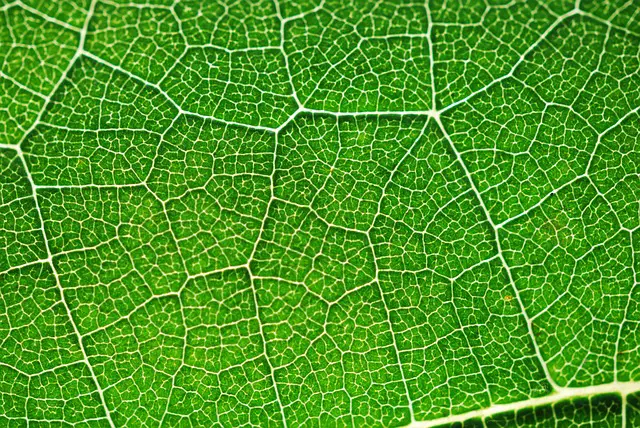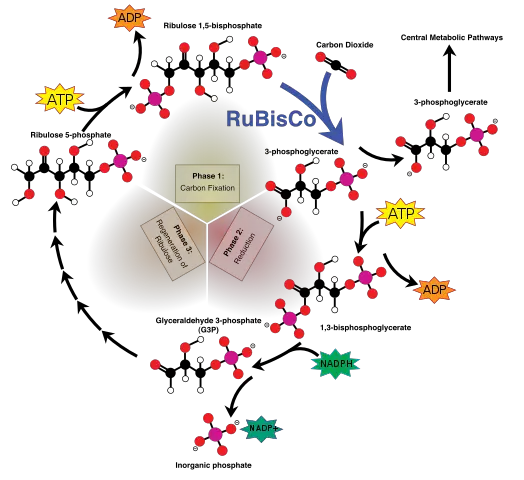Photosynthesis
** Definition, Equation, Process & Cellular Respiration
Definition: What is Photosynthesis?
Basically, photosynthesis is a chemical process through which light energy is used to convert/assemble inorganic material (water and carbon dioxide) into organic molecules. Organisms capable are referred to as autotrophs/photoautotrophs and include some bacteria (Cyanobacteria), algae and all plants.
Given that photosynthesis is the only process through which light energy is used to assemble inorganic molecules into organic molecules that can be used as a source of energy by other organisms, it's without a doubt one of the most important chemical processes on earth.
* The word autotroph comes from the Greek words "auto" and "trophe" which means "self" and "nourishment" respectively.
Photosynthetic Factory
For a majority of plants, leaves act as photosynthetic factories. As such, they are well suited for all processes of photosynthesis. Like solar panels, leaves, for the most part, are thin and broad with the broad part of the leaf facing the sun. This allows for maximum light interception.
Plants have been shown to re-orient their leaves in a manner that ensures maximal light interception during the day. This ensures that sufficient light energy is collected for photosynthesis.
Apart from the general shape of the leaf and the ability to re-orient, some of the other leaf structures involved in photosynthesis include:
- Chloroplast - The chloroplast is the machinery/site of photosynthesis
- Chlorophyll - Pigment within the chloroplast
- Vascular system in the mesophyll layer - xylem that supplies water
Photosynthesis Process and Reactions
Depending on ecology, there are three main types of photosynthesis:
C3 Cycle
C3 cycle or C3 photosynthesis is the type of photosynthetic reaction observed in a majority of plants (80-90 percent of all plants). Plants in which this form of photosynthesis occurs are referred to as C3 plants.
Stages of C3 (Calvin cycle) photosynthesis
Carbon Dioxide Fixation Stage
During the day, carbon dioxide diffuses through the pores and into the mesophyll cells. Here, CO2 diffuses into the stroma where sugar is synthesized. In the stroma, the enzyme ribulose bisphosphate carboxylase catalyzes a reaction between the gas (CO2) and three molecules of a five-carbon acceptor known as ribulose bisphosphate (RuBP).
These reactions result in the production of a 6 carbon compound that is then split to produce 2 molecules of 3-phosphoglyceric acid.
Carbon dioxide fixation is a light-independent reaction that may be represented as follows:
C02 + RuBP ------- (Rubisco) --------> 2 (3- PGA)
Carbon Reduction Stage
During the reduction stage, 6 molecules of APT and NADPH convert the 3-PGA into 6 molecules of glyceraldehyde 3-phosphate. As a result, ATP is converted to ADP (having lost a terminal phosphate atom) while the NADPH is converted to NADP+.
Regeneration
During the regeneration phase, a single molecule of G3P is transported to the cytoplasm where it is involved in the formation of compounds required by the plant. The other G3P, however, undergo further reactions to produce RuBP, glucose and other sugars as well as various other organic compounds.
C4 Cycle
In C4 plants (pineapple, corn, and sugarcane among others) the photosynthesis takes place in the mesophyll and bundle sheath cells. As is the case with the C3 cycle, C4 cycle is also light independent.
In the mesophyll cells, the hydration of carbon dioxide produces a bicarbonate ion in the presence of carbonic anhydrase. Using the carbonate ions, a carbon fixing enzyme known as phosphoenolpyruvate carboxylase, a 3 carbon phosphoenolpyruvate (PEP) is converted to oxaloacetate (a 4 carbon compound).
The PEP enzyme is absent in the C3 cycle but present in the C4 cycle. This presents a big advantage for C4 plants given that the enzyme is capable of fixing carbon dioxide at low concentrations (carbonate).
For this reason, C4 plants do not necessarily need to have their stomata open to absorb more carbon dioxide for photosynthesis.
The photosynthetic reaction that occurs in the mesophyll may be represented as follows:
CO2 + H20 -------- (carbonic anhydrase) -----> HCO3 - + H+
HCO3- + PEP -------- (PEP ENZYME) ----------> OAA (Oxaloacetate)
In the mesophyll cells, Oxaloacetate is converted to malate (a 4 carbon compound) in the presence of NADPH before being transported to the bundle sheath cells.
* Among C4 plants, bundle sheath cells are a group of specialized cells located around the vascular bundles in leaves.
In the bundle sheath cells (in the chloroplast of these cells), malate is converted to a 3 carbon pyruvate following the removal of CO2 through decarboxylation (this reaction produces CO2, pyruvate, and NADPH).
Whereas pyruvate moves to the mesophyll layer for phosphorylation (to form PEP) carbon dioxide enters the C3 cycle where it goes through biochemical reactions to produce the 3 carbon glyceraldehyde-3-phosphate.
This process ensures that there is a high concentration of carbon dioxide. In this case, then, rubisco serves as a carboxylase that plays an important role in reducing photorespiration.
Photorespiration - Is a respiratory process where the plant retains high levels of oxygen during the light period (stomata closed). This proves to be a problem during photosynthesis given that oxygen, in high levels, competes with carbon dioxide for the active sites of rubisco. Here, gaseous exchange does not occur (oxygen leaving and carbon dioxide entering). As a result, cellular respiration, rather than photosynthesis takes place during this photorespiration.
CAM Cycle (Crassulacean Acid Metabolism)
CAM is a form of photosynthesis common among members of the Crassulaceae family. Unlike C4 plants, plants described as CAM tend to fix carbon dioxide at night. and so, CAM plants may also be described as C4 plants.
At night, the pores open allowing the leaves to take in carbon dioxide. In the presence of PEP carboxylase (also found in C4 plants) Carbon dioxide is fixed to form oxaloacetate which is then converted to malate. The next morning, malate is transported to the cytosol where it undergoes decarboxylation which releases carbon dioxide needed for the Calvin cycle.
* For plants in very hot and dry environments, this process ensures that the leaves do not lose excess water (by opening during the day). Moreover, it ensures that the leaves have sufficient carbon dioxide required for photosynthesis during sunlight.
During the night, pores open allowing the plant to take in carbon dioxide and release excess oxygen. This also helps prevent photorespiration.
Photosynthesis Overview
Generally, photosynthesis is divided into two main stages that include:
Light-dependent Reactions
Light-dependent reactions are reactions that convert light energy into chemical energy (ATP and NADPH).
They occur within the thylakoid membranes of chloroplasts and involve three main steps which include:
Photosystem excitation - Once chlorophyll absorbs light energy, delocalized electrons within the pigments are energized and become excited. These electrons are then transferred to the carrier molecules that are located within the thylakoid membrane (electron acceptor).
ATP production - As the electrons pass through the electron transport chain (within the thylakoid membrane) they lose energy as an electrochemical gradient is created within the thylakoid. Using hydrogen ions translocated in the thylakoid, ATP synthase catalyzes the synthesis of ATP in a process known as photophosphorylation.
As this step comes to an end, the now de-energized electron are taken up by photosystem 1 from photosystem II.
Water photolysis and NADP+ reduction - In this phase, the electrons from Photosystem I may be used to reduce NADP+ to NADPH-. Along with ATP, this molecule plays an important role in light-independent reactions.
* Light energy in light dependent reactions split water into oxygen and positive hydrogen ions.
Light-independent Reactions
Also referred to as Calvin cycle, energized electrons from former reactions provide the energy required to synthesize sugars.
The Calvin cycle, which occurs in the stroma, is divided into three basic stages that include:
- Fixation
- Reduction
- Regeneration
* These steps are described in the C3 cycle.
Photosynthesis and Cellular Respiration
Although photosynthesis and cellular respiration are different processes, products of one are reactants of the other. The two processes are therefore opposite of each other.
Although plants are well known for their ability to manufacture food through photosynthesis, cellular respiration also takes place in the mitochondria of their cells. Where oxygen is used, this process is known as aerobic respiration.
Apart from plants, cellular respiration also takes place in animals and is the process through which energy is released from organic compounds.
The following are general representations (formulae) for both photosynthesis and cellular respiration:
Cellular Respiration (aerobic)
C6H12O6 + 6O2 → 6CO2 + 6H2O + 32 ATP
Photosynthesis
6CO2 + 6H2O —> C6H12O6 + 6O2
By looking at the two formulas, it becomes evident that the products of one of the reactions are reactants of the other. This shows the relationship between the two reactions in nature.
As animals break down sugars in their cells, carbon dioxide and water are released. Plants can then use these products to manufacture food and the cycle continues.
More on Plant Biology and Photosynthesis:
Leaf Structure under the Microscope
Learn more about Chloroplasts and Chromoplasts
Return to Plant Biology overview
Return from learning about Photosynthesis to MicroscopeMaster home
References
Harvey J.M. et al,. (2018). Photosynthesis: Structures, Mechanisms, and Applications.
Matthew P. Johnson. (2016). Photosynthesis.
William G. Hopkins. (2008). Photosynthesis and Respiration.
Links
https://openoregon.pressbooks.pub/mhccmajorsbio/chapter/calvin-cycle/
Find out how to advertise on MicroscopeMaster!

![Simple photosynthesis diagram by Daniel Mayer (mav) - original imageVector version by Yerpo [CC BY-SA 4.0 (https://creativecommons.org/licenses/by-sa/4.0)] Simple photosynthesis diagram by Daniel Mayer (mav) - original imageVector version by Yerpo [CC BY-SA 4.0 (https://creativecommons.org/licenses/by-sa/4.0)]](https://www.microscopemaster.com/images/256px-Simple_photosynthesis_overview.svg.png)





